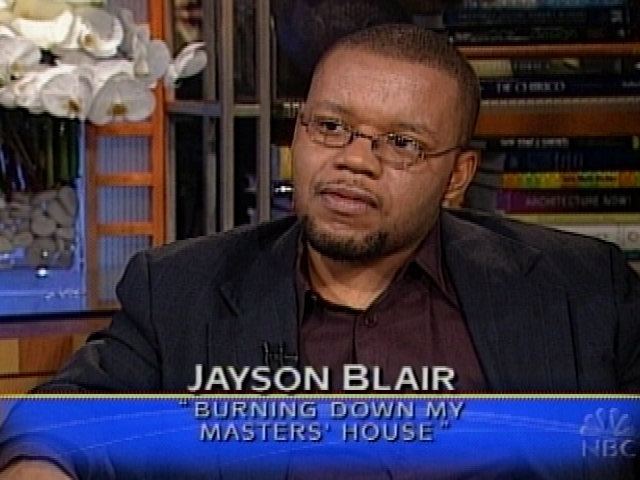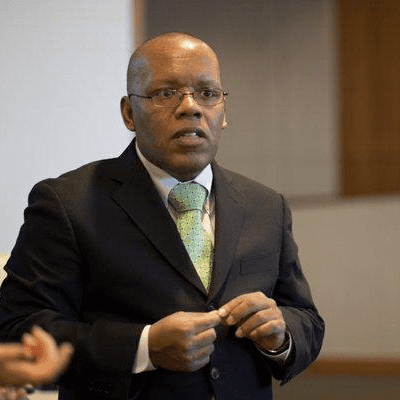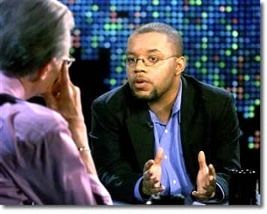Occupation Writer, journalist Name Jayson Blair | Role Journalist Parents Thomas Blair | |
 | ||
Full Name Jayson Thomas Blair Books Burning Down My Master's House: My Life at the New York Times Similar People | ||
Jayson blair the former new york times journalist
Jayson Thomas Blair (born March 23, 1976) is a former American journalist associated with The New York Times. He resigned from the newspaper in May 2003 in the wake of the discovery of plagiarism and fabrication in his stories.
Contents
- Jayson blair the former new york times journalist
- A fragile trust jayson blair plagiarism and the new york times
- Background
- Plagiarism and fabrication scandal
- Aftermath
- Later career
- In popular culture
- References

Blair published a memoir of this period, entitled Burning Down My Master's House (2004), recounting his career, a diagnosis of bipolar disorder after his resignation, and his view of race relations at the newspaper. He later established a support group for people with bipolar disorder, and a life coaching company based in the Virginia suburbs of Washington, DC.

A fragile trust jayson blair plagiarism and the new york times
Background

Blair was born in Columbia, Maryland, the son of a federal executive and a schoolteacher. While attending the University of Maryland, College Park, he was a student journalist. For 1996-1997, he was selected as the second African-American editor-in-chief of its student newspaper, The Diamondback. According to a 2004 article by the Baltimore Sun, some of his fellow students opposed his selection.

After a summer interning at The New York Times in 1998, Blair was offered an extended internship there. He declined in order to complete more coursework for graduation. But he returned to The New York Times in June 1999, with a year of coursework left to complete. That November, he was classified as an "intermediate reporter." He was later promoted to a full reporter and then to editor.
Plagiarism and fabrication scandal

On April 28, 2003, Blair received a call from Times national editor Jim Roberts asking him about similarities between a story he had written two days earlier and one published April 18 by San Antonio Express-News reporter Macarena Hernandez. The senior editor of the San Antonio Express-News had contacted The New York Times about the similarities between Blair's article in The New York Times and Hernandez's article in his paper.
The resulting inquiry led to the discovery of fabrication and plagiarism in a number of articles written by Blair. Some fabrications include Blair's claims to have traveled from New York to the city mentioned in the dateline, when he did not.
Suspect articles include the following:
After internal investigations, The New York Times reported on Blair's journalistic misdeeds in an "unprecedented" 7,239-word front-page story on May 11, 2003, headlined "Times Reporter Who Resigned Leaves Long Trail of Deception." The story called the affair "a low point in the 152-year history of the newspaper." On the NPR radio show Talk of the Nation, Blair explained that his fabrications started with what he thought was a relatively innocent infraction: using a quote from a press conference which he had missed. He described a gradual process whereby his ethical violations became worse, and contended that his main motivation was a fear of not living up to the expectations that he and others had for his career.
After the scandal broke, some 30 former staffers of The Diamondback, who had worked with Blair when he was editor-in-chief at the university newspaper, signed a 2003 letter alleging that Blair had made four serious errors as a reporter and editor while at the University of Maryland. They said these and his work habits brought his integrity into question. The letter-signers alleged that questions raised by some of these staffers at the time were ignored by Maryland Media, Inc. (MMI), the board that owned the paper.
Aftermath
The investigation, known as the Siegal committee, found heated debate among the staff over affirmative action hiring, as Blair is African American. Jonathan Landman, Blair's editor, told the Siegal committee he felt that Blair's being black played a large part in the younger man's initial promotion in 2001 to full-time staffer. "I think race was the decisive factor in his promotion," he said. "I thought then and I think now that it was the wrong decision."
Others disagreed. Five days later, New York Times op-ed columnist Bob Herbert, an African American, asserted in his column that race had nothing to do with the Blair case:
"Listen up: the race issue in this case is as bogus as some of Jayson Blair's reporting." Herbert said, "[F]olks who delight in attacking anything black, or anything designed to help blacks, have pounced on the Blair story as evidence that there is something inherently wrong with The New York Times's effort to diversify its newsroom, and beyond that, with the very idea of a commitment to diversity or affirmative action anywhere. And while these agitators won't admit it, the nasty subtext to their attack is that there is something inherently wrong with blacks."
Two senior editors, Executive Editor Howell Raines and Managing Editor Gerald Boyd, resigned after losing newsroom support in the aftermath of the scandal.
After resigning from The New York Times, Blair struggled with severe depression and, according to his memoir, entered a hospital for treatment. He was diagnosed with bipolar disorder for the first time. He has acknowledged that he had been self-medicating when he was dealing with substance abuse of alcohol and cocaine in earlier years.
Later career
Blair later returned to college to complete his postponed degree. At one time he said he considered going into politics.
The year after he left the Times, Blair wrote a memoir, Burning Down My Master's House, published by New Millennium Books in 2004. Its initial print run was 250,000 copies; some 1,400 were sold in its first nine days. The Associated Press reported that the potential audience for his book may have gained enough information from the New York Times coverage of the reporting scandal. Although most reviews were critical, sales of the book increased after Blair was interviewed by King and Fox News Channel host Bill O'Reilly.
In his book Blair revealed extended substance abuse, which he had ended before he resigned from the newspaper, and a struggle with bipolar disorder, which was diagnosed and first treated after he resigned. He also discussed journalistic practices at the Times, and his view of race relations and disagreements among senior editors at the newspaper.
In 2006 Blair was running a support group for people with bipolar disorder, for which he has received continuing treatment. By 2013 Blair was working as a certified life coach, where he owned and operated a company based in Centreville, Virginia, in the Washington, D.C. suburbs.
